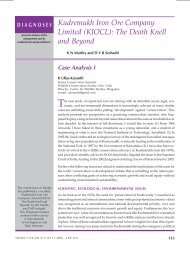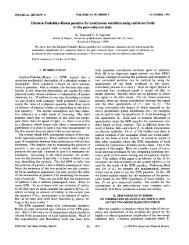Finding Knees in Multi-objective Optimization
Finding Knees in Multi-objective Optimization
Finding Knees in Multi-objective Optimization
You also want an ePaper? Increase the reach of your titles
YUMPU automatically turns print PDFs into web optimized ePapers that Google loves.
Fig. 2. Calculation of the angle measure. The standard version just calculates α, the <strong>in</strong>tensified<br />
version takes 4 neighbors <strong>in</strong>to account and calculates the maximum of α β γ, and δ.<br />
3.1 Angle-based Focus<br />
In the case of only two <strong>objective</strong>s, the trade-offs <strong>in</strong> either direction can be estimated<br />
by the slopes of the two l<strong>in</strong>es through an <strong>in</strong>dividual and its two neighbors. The angle<br />
between these slopes can be regarded as an <strong>in</strong>dication of whether the <strong>in</strong>dividual is at<br />
a knee or not. For an illustration, consider Figure 2 (a). Clearly, the larger the angle α<br />
between the l<strong>in</strong>es, the worse the trade-offs <strong>in</strong> either direction, and the more clearly the<br />
solution can be classified as a knee.<br />
More formally, to calculate the angle measure for a particular <strong>in</strong>dividual xi, we<br />
calculate the angle between the <strong>in</strong>dividual and its two neighbors, i.e. between ¡ xi¢ 1£ xi¤<br />
and ¡ xi £ xi¥ 1¤ . These three <strong>in</strong>dividuals have to be pairwise l<strong>in</strong>early <strong>in</strong>dependent, thus<br />
duplicate <strong>in</strong>dividuals (<strong>in</strong>dividuals with the same <strong>objective</strong> function values, which are<br />
not prevented <strong>in</strong> NSGA-II per se) are treated as one and are assigned the same anglemeasure.<br />
If no neighbor to the left (right) is found, a vertical (horizontal) l<strong>in</strong>e is used to<br />
calculate the angle. Similar to the standard cuboid-length measure, <strong>in</strong>dividuals with a<br />
larger angle-measure are preferred.<br />
To <strong>in</strong>tensify the focus on the knee area, we also suggest a variant which uses four<br />
neighbors (two <strong>in</strong> either direction) <strong>in</strong>stead of two. In that case, four angles are computed,<br />
us<strong>in</strong>g on either side either the closest or the second closest neighbor (cf. angles.<br />
α£ β£ γ£ δ <strong>in</strong> Figure 2). The largest of these four angles is then assigned to the <strong>in</strong>dividual.<br />
Calculat<strong>in</strong>g the angle measure <strong>in</strong> 2D is efficient. For more than two <strong>objective</strong>s, however,<br />
it becomes impractical even to just f<strong>in</strong>d the neighbors. Thus, we restrict our exam<strong>in</strong>ation<br />
of the angle-based focus to problems with two <strong>objective</strong>s only. The utility-based<br />
focus presented <strong>in</strong> this section, however, can be extended to any number of <strong>objective</strong>s.<br />
3.2 Utility-based Focus<br />
An alternative measure for a solution’s relevance could be the expected marg<strong>in</strong>al utility<br />
that solution provides to a decision maker, assum<strong>in</strong>g l<strong>in</strong>ear utility functions of the form<br />
U ¡ ¡ ¡ ¡<br />
x¤©¨ λ � λ¤ f1<br />
x¤ 1 f2 , with ��� 0£ 1� all λ be<strong>in</strong>g equally likely. x£ 뤧¦ For illustration,<br />
let us first assume we would know that the DM has a particular preference function<br />
U ¡ , with some λ� known . Then, we could calculate, for each <strong>in</strong>dividual xi <strong>in</strong> x£ λ� ¤ the<br />
population, the DM’s utility U ¡ xi of that <strong>in</strong>dividual. Clearly, given the choice among<br />
£ λ� ¤<br />
all <strong>in</strong>dividuals <strong>in</strong> the population, the DM would select the one with the highest utility.
















